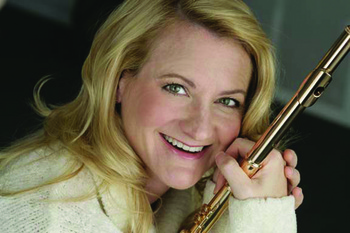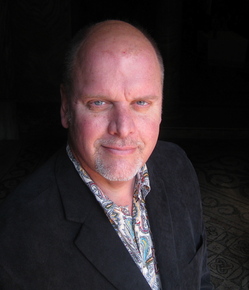Ann Arbor Symphony's season-opening concert is 'Made in Michigan'

Guest soloist Amy Porter
If you’re a locavore whose predilections extend to classical music, mark Sept. 26 (Sunday afternoon) on your calendar. When the Ann Arbor Symphony Orchestra presents “Made in Michigan,” its first concert of the 2010-2011 season, at Hill Auditorium, it’s more than a majority of the music and performers who are from these parts.
Even the mighty Frieze Memorial Organ — featured in a distinctly un-Michigan (but oh-so-wonderful) composition, the Saint-Saens “Organ Symphony,” with Michigan Theater organist Steven Ball officiating — has its origins in the state: 12 of its 120-plus ranks of pipes date back to the organ built by the Farrand & Votey Company of Detroit in 1893 and installed in University Hall in 1894.
A2SO Music Director Arie Lipsky calls the concert “an historic moment.” Certainly, it celebrates Michigan history by honoring an institution, the University of Michigan Bentley Historical Library — 75 years old this year — dedicated to chronicling the past of the state and the University of Michigan. U-M President Mary Sue Coleman will make opening remarks at the concert.
PREVIEW
- Who: The Ann Arbor Symphony Orchestra, Arie Lipsky, music director. With soloists William Bolcom and Joan Morris; Amy Porter, flute; and Steven Ball, organ.
- What: Opening concert of the A2SO season, specifically highlighting the Great Lakes State.
- Where: Hill Auditorium, 825 North University Avenue.
- When: Sunday, September 26, 4 p.m.
- How much: $10-$53, with discounts for students, seniors and groups and special offers for new season subscribers. Call the A2SO, 734-994-4801 or visit the A2SO website.
“It’s a real town-and-gown celebration,” A2SO Executive Director Mary Steffek Blaske wrote in an e-mail, explaining how Jim Irwin, a longtime supporter of both the Bentley and the A2SO, brought her and Bentley Director Francis X. Blouin together to brainstorm about possible ways to celebrate the library’s big anniversary.
“We came up with this concert as a terrific way to celebrate the non-textual holdings in the library,” she said — in this case, the music. “From here,” she continued, “we developed the ‘made in Michigan’ theme so that the entire concert had a Michigan (both State and University of) flair.”
The Bentley, for example, houses the papers of composers like the University of Michigan’s William Bolcom and his wife and partner-in-music, the singer Joan Morris; the late William Albright; and Bright Sheng. Bolcom and Morris and Albright are part of Sunday’s program, with Albright’s “Sleight of Hand Rag” representing his output in that area.
But when Lipsky talks about “historic moments,” it goes beyond all that. With “Made in Michigan” as the theme, the concert brings two major living composers, Bolcom and Michael Daugherty, the latter also affiliated with the U-M, to the Hill stage. Indeed, both Bolcom and Morris will be on hand to perform the selections from Bolcom’s “Cabaret Songs” on the bill.
And Daugherty will be, if not on stage, in the audience as another U-M faculty member, flutist Amy Porter, performs Daugherty’s “Trail of Tears” concerto in its Michigan premiere and its second-ever performance. The work, written for Porter, is a co-commission by the American Composers Orchestra, A2SO, Delaware Symphony Orchestra and Omaha Symphony. It had its world premiere in Omaha last March.
“The Shostakovich 1954 “Festive Overture,” a work with no discernible Michigan connection (but one to the October Revolution and the 1980 Summer Olympics!), rounds out the bill.
Though Daugherty is a Michigander these days, the concerto he wrote for his colleague Porter has its origin in history that transcends the state’s: the forced removal of all Native Americans living east of the Mississippi River that began with the passage of President Andrew Jackson’s Indian Removal Act of 1830.
In 1838, 15,000 Cherokee men, women, and children were forcibly taken from their homes by the U.S. Army and placed in stockades and camps in Tennessee. From November 1838 to March 1839, the Cherokee, with scant clothing and many without shoes, were forced to make a 800-mile march for relocation in Oklahoma during the bitter cold of winter. Suffering from exposure, disease, and starvation, nearly 4,000 Cherokee died during the five-month march known as the “Trail of Tears.”

Michael Daugherty
“One of the tragedies of human history is the forced removal of peoples from their homeland for political, economic, racial, religious or cultural reasons,” Daugherty writes in a composer’s note for “Trail of Tears.” “My flute concerto is a musical journey into how the human spirit discovers ways to deal with upheaval, adversity and adapting to a new environment.
“The first two movements,” he goes on, “are played without pause. The first movement reflects on meaningful memories of things past, inspired by a quotation from the Native American leader Geronimo (1829-1909): ‘I was born on the prairies where the wind blew free and there was nothing to break the light of the sun.’ The end of the first movement becomes a death march, marked ‘Trail of Tears,’ and concludes with a turbulent instrumental coda.
“The reflective second movement, entitled ‘incantation,’ meditates on the passing of loved ones and the hope for a better life in the world beyond. The third and final movement, ‘sun dance,’ evokes the most spectacular and important religious dance ceremony of the Plains Indians of 19th-century North America. Banned on Indian reservations for a century by the U.S. government, the dance is practiced again today. I have composed my own fiery musical dance to suggest how reconnecting with rituals of the past might create a path to a new and brighter future.”
“Trail of Tears” is not the first Daugherty piece for the A2SO. “We’ve done several of his pieces,” Lipsky said by phone last week. And that experience should stand the orchestra in good stead.
“His music not easy to perform,” Lipsky said. “It’s very demanding, both musically and technically speaking, and the rhythm, too. That’s always a big factor — it’s tricky and demanding. I’m looking forward to working together with him again. He knows exactly what he wants.”
From the beginning, though, flutist Porter was there to help Daugherty explore what was possible on her instrument.
“I had input in the sense of I suppose letting him know what the instrument could do,” Porter said by phone last week. “That’s one of the things I respect about a great composer, being inquisitive about the instrument.” What the instrument can do has been affected, she said, by new techniques developed, among other places, in Europe and Japan.
“For the medium that Michael was writing in, it was not so much cutting-edge techniques, but more exotic sounds,” she said.
Said Daugherty, via e-mail, “The flute is a cross-over instrument that, for hundreds of years, has been part of the sound worlds of American popular-classical music and Native American Indian music. Amy Porter and I collaborated on ‘Trail of Tears.’ For two years, she came over to my home studio and improvised every possible extended flute technique (bending of notes, singing and playing the flute at the same time, unusual trills, etc.). I recorded everything Amy played, studied it carefully and then began to slowly piece together my concept for ‘Trail of Tears.’”
Is Porter looking forward to playing the work again? You bet.
“This is my piece,” she said. “I live it. I don’t just play it. I don’t just play it and I don’t just interpret it. The sounds that I’m making, that’s what I’m living. This is my piece, something that I’m living through the sounds that I’m making on my instrument, and they come from inside of me, not from the instrument. I’ve been with it since the beginning.”
Asked what the piece means to her, she paused. “These are sounds that are in my blood,” she said, “and I feel like I can interpret it very well. I have played it for many flute players around the world, and it’s only alive when the sounds are played. It’s not what you see on the page. If you look at the score and notes, for other flute players it will be different. It’s an incredibly dynamic work.”
Added Lipsky, for whom the flute is a second instrument after cello: “I’m sure it will be one of the important flute works of the 21st century.”
Susan Isaacs Nisbett is a free-lance writer who covers classical music and dance for AnnArbor.com.

